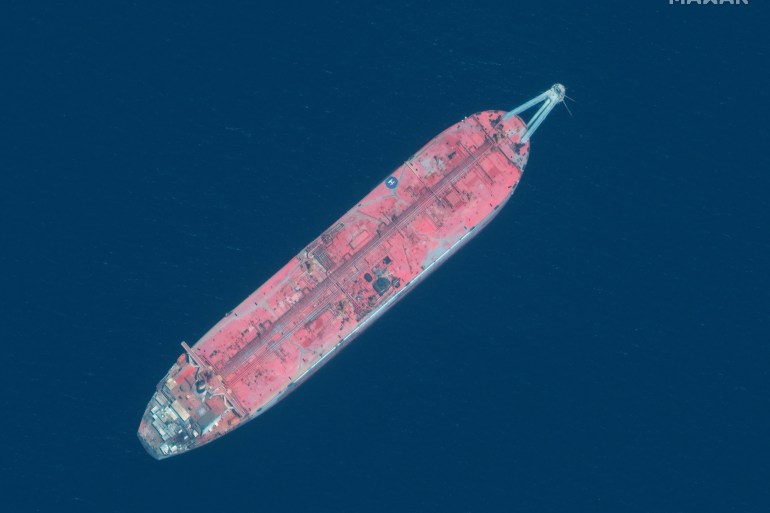Houthi rebels in Yemen have given a long-awaited approval to a United Nations plan to visit and assess a deteriorating oil tanker off Yemen’s coast that is threatening to spill 1.1 million barrels of crude oil into the Red Sea.

Staff and equipment could be expected to arrive at the tanker by late January or early February, UN spokesman Stephane Dujarric told reporters on Tuesday.
Hussein al-Azzi, the Houthi deputy foreign minister, on Sunday said the Houthi authorities had sent a letter confirming they would welcome the UN team of experts, adding they were waiting for confirmation of an arrival date.
“It represents an important step forward in this critical work,” Dujarric said, adding the letter was received on Saturday.
“We still have to work out the exact deployment timeline because it’s going to depend on the market availability of the required equipment,” he said.
When asked how this plan is different from the one the Houthis agreed to in July, Dujarric stressed the new accord, reached on Saturday, is more formal.
“The objective of the UN mission is to assess the vessel and undertake initial maintenance as well as to formulate recommendations on what further action is required to neutralize the risk of an oil spill.”
Preventing an ‘environmental disaster’
The UN has warned the Safer, stranded since 2015, could spill four times as much oil as the 1989 Exxon Valdez disaster near Alaska, but access to the vessel has been complicated by the war in Yemen.
The Iran-aligned Houthi group controls the area where the tanker is moored and the national oil firm that owns it.
Dujarric said the experts could undertake light maintenance. The UN has a plan, but now needs to procure equipment and permits which will take time, he explained.
“The de facto authorities have assured us that they will provide all the necessary facilitation to ensure that the expert team can deploy as quickly as possible,” he said.
The Safer, built in 1974, is moored off the Ras Issa oil terminal, 60km (40 miles) north of the key port of Hodeidah.

The area is held by the Houthis, but the high seas are controlled by a Saudi-led coalition that intervened in Yemen in 2015 against the group and has prevented it from selling oil.
UN and Houthi officials say water has entered the Safer’s engine room at least twice since 2015. The latest leak in May was plugged by Safer Corp divers and Houthi naval units.
Read Also: Mexico Ambush Arrest over Mormon Massacre
Apart from corrosion to the ageing vessel, essential work to curb explosive gases in its storage tanks has been neglected for years.
The UN says a major rupture could severely harm Red Sea ecosystems and shut Hodeidah port, Yemen’s main entry point for imports and aid.
Independent studies show it could also affect countries as far away as Djibouti and Eritrea as well as Saudi Arabia and expose more than 8.4 million people – many already vulnerable due to famine after years of war – to heightened pollution.
In August, UN Secretary-General Antonio Guterres warned against allowing the Safer to create a situation like the oil spill earlier this year in Mauritius or the explosion at the Beirut port, where neglected hazardous materials cargo exploded like a bomb, leveling neighbourhoods and killing nearly 200 people.

“The agreement to allow access to the Safer tanker is welcome [and overdue]. Making it safe as soon as possible will prevent a potentially huge environmental disaster,” Britain’s ambassador to Yemen, Michael Aron, said on Wednesday.
